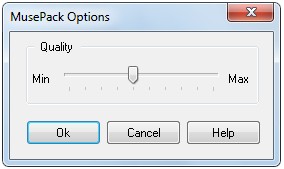Musepack was developed using the MP2 codec as a starting point, but many features have since been added, including:
subband selectable M/S encoding (as in AAC)
The psychoacoustic model of MPC is based on MPEG ISO model 2, but is extended by CVD (clear voice detection). The quantization algorithm of the MPC encoder performs spectral shaping of the noise, called adaptive noise shaping (ANS), in order to overcome the low frequency resolution of the polyphase quadrature filter bands.
In the past, MPC has been under suspicion of violating multiple patents (MP2, PNS, subband). According to the developers of MPC, all patented code has been removed and it is now believed to be free of patent encumbrance. However, one PNS patent application is still active,[2] and it is not trivial to know if MPC's own "noise substitution techniques" avoid its scope or not.
MPC uses the APEv2 tag metadata container.
Musepack is mainly optimized for transparent encoding at the "--standard" preset (175-185 kbit/s). Very few optimisations have been made at lower bitrates (like 128 kbit/s). Nevertheless, various listening tests have been conducted in which Musepack has performed well at both lower and higher bitrates

Musepack is a purely variable bitrate format and does not work at a constant bitrate. A big part of Musepack's quality comes from its highly variable bitrate handling which results in low bitrate for less demanding regions of the audio data and higher bitrate where it's needed. This allows MPC files to be as small as possible and not lose any valuable bits like encoders that work at a constant bitrate. After all, the purpose of a lossy audio encoder is to provide the highest possible quality at the lowest possible file size, and Musepack represents progress, as opposed to old, suboptimal legacy methods.
Just use the Quality-Switch for any kind of fine-tuning as it gives the most optimized quality possible.
|
Copyright (c) 2013 AudioDope team. All rights reserved.
|
|
What do you think about this topic? Send feedback!
|